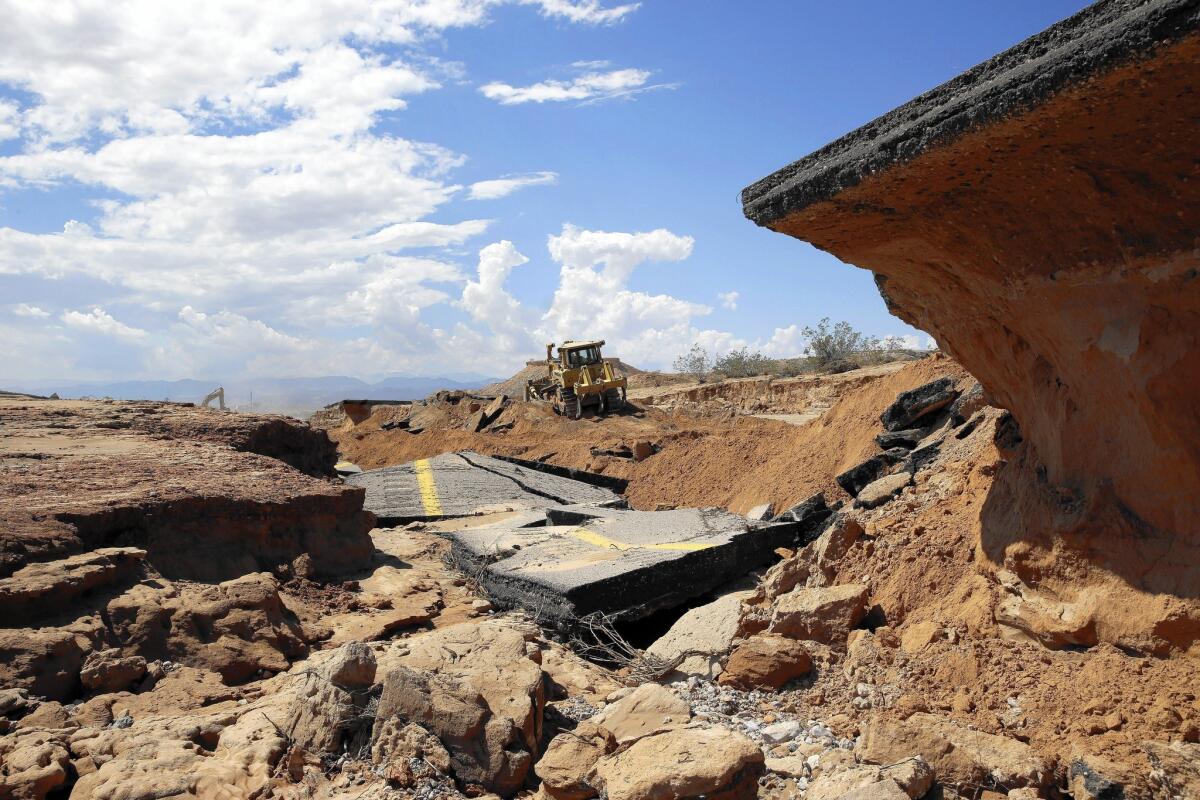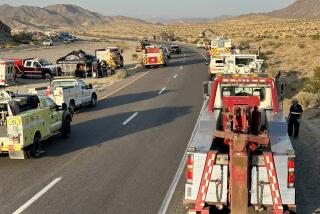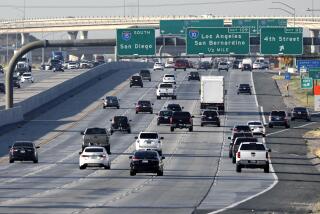In Nevada, washed-out interstate is truckers’ nightmare

- Share via
Reporting from LAS VEGAS — Mother Nature works in confounding ways: snow flurries in Phoenix, a balmy Christmas in Buffalo, and this week’s catastrophic flood in the normally parched desert 50 miles north of this resort city.
In what some term the area’s worst storm in decades, a 2-mile-long stretch of Interstate 15 in rural Moapa was destroyed by 4 inches of rain that lashed the roadway in just an hour on Monday. The dying throes of Tropical Storm Norbert dumped as much rain on the area in 60 minutes as Las Vegas gets in a year.
------------
FOR THE RECORD:
Nevada highway washout: In the Sept. 13 Section A, an article detailing the damage a storm did to Interstate 15 in Nevada misspelled the town of Pahrump as Parumph. —
------------
The mother of all road detours has come for thousands of vacationers, sightseers and long-distance truckers, including delays of eight hours or more, with vehicles diverted onto a gantlet of winding two-lane roads that squiggle into the cacti and scrub brush.
The roundabout has resulted in millions of dollars in losses for regional trucking companies and their customers. Drivers on already tight schedules — and with legal limits on how long they can spend on the road — have thrown up their hands.
“The worst backup I’ve seen in 25 years as a long-distance trucker,” said Ken Leth, 58, a driver for Las Vegas-based Truline Corp. trucking company who says he has clocked 3 million road miles. “You couldn’t get up and running. It was 20 miles an hour most of the way.”
For customers, waits of up to 36 hours for deliveries have meant that hospitals have run out of clean linens for patients and rural gas stations have run out of fuel.
“It’s been tough,” said Paul Enos, chief executive of the Nevada Trucking Assn., which represents 530 companies. “Some people are getting desperate.”
In Nevada, 94% of all manufactured goods are delivered by truck — versus 69% nationally, he said. Much of that cargo travels along I-15, a commercial artery that in the damaged area handles 25,500 vehicles per day.
“We’ve been trying to get hours-of-service exemption so guys can wait out the delays and stay on the road,” he said. “There are just so many towns out there that depend on trucks.”
Since the storm hit, I-15 has been closed in both directions, and state transportation crews have worked around the clock to repair the damage. Officials planned to open one lane in either direction by late Friday, but even if that happens, traffic will be restricted to cars and light trucks.
That means for at least another week, 18-wheelers will have to continue on a circuitous route through two states.
Leth and others consulted their trucker’s atlas for this time-killer: His northbound semi was waved off I-15 onto U.S. Highway 93, through tiny Alamo and Caliente to the town of Panaca. Then he headed east on State Route 319, which becomes Utah Route 56, and connected back onto I-15 in Cedar City, Utah.
That’s 225 miles on narrow two-lane roads, versus 150 miles on the interstate.
For Leth, who was hauling dairy products to Denver, the detour took more than eight hours to cover ground that would have taken three hours on I-15: “I was a captive audience — all I could do is sit in traffic.”
For a time, all traffic was diverted onto this route. Now cars and trucks travel east from the interstate through Valley of Fire State Park — with highly reduced speed limits — and back on the highway 40 miles and several traffic-congested hours later, just 18 miles from where they started.
From his check-in desk, Nolan Avery, owner of the 40-room Shady Hotel in Caliente, has watched the slow-moving Nevada version of “Carmageddon.”
“Oh my gosh, that first day was just a nightmare, with bumper-to-bumper cars and trucks. At one point it took two hours to get five miles,” he said. “People were irate, just stuck in their vehicles. Trucks broke down, which made things worse.”
The last few days have gotten better, Avery said. “Now it’s nothing but trucks. One rumbles past here just about every 10 seconds.”
Frustrated motorists have veered off the detour route — including the tour bus operator who abandoned a trip to Zion National Park in southern Utah for one to nearby Death Valley. His reason: You just couldn’t get there from here, not in any timely way.
“We’re getting lots of tour buses in here,” said Vivien Rudzena, manager of the Horizon Market in Parumph. “The line to our bathroom goes around the corner. I tell people to drink plenty of water. It’s a desert out there.”
Some are calling this week’s downpour southern Nevada’s 100-year storm, but transportation officials say that’s an understatement.
“Our system is equipped to handle those ‘worst-in-100-years’ storms, but this was much worse than that,” said Mario Gomez, an assistant engineer with the Nevada Department of Transportation.
He said the drainage system, designed to handle a river of water 200 feet wide and 20 feet deep, overflowed, sending 2 feet of water onto the roadway, toppling cars and ripping up the roadway. “The sheer force of the water scours the road. It rips and tears everything in its path.”
Gomez arrived at the gutted stretch of highway to see sheer devastation. “The road was just gone in places,” he said. “I’ve never seen as severe a force of nature in my life, and I’ve got a new respect.”
Enos said truckers were preparing for the long and hard road ahead. Drivers were teaming up to outlast the delays and some were avoiding Nevada entirely. Still, the delays are taking their toll.
“You figure that it costs about $80 an hour to run a long-distance truck, with salary and fuel,” he said. “So you get long delays like this and multiply the losses by tens of thousands of trucks, and the losses start to add up real fast.”
Gomez said the big trucks would be kept off the interstate until all four lanes reopen because there are several hilly stretches that would cause long lines behind lumbering 18-wheelers in low gear.
“We know I-15 is a commercial lifeline to Utah, California and the rest of the country,” he said. “So it’s extremely important to get things open as soon as possible. I feel horrible for those truckers. But we’re working as fast as we can.”
But where there is economic famine there is also feast. Shady Motel owner Avery says business has been good. “For a small town like ours, something like this is a financial boost, if only for a few short weeks.”
More to Read
Sign up for Essential California
The most important California stories and recommendations in your inbox every morning.
You may occasionally receive promotional content from the Los Angeles Times.











